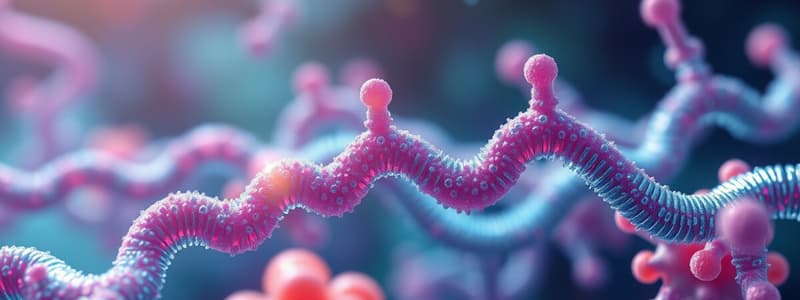Podcast
Questions and Answers
What happens to enzyme activity in neutral solutions?
What happens to enzyme activity in neutral solutions?
- Enzyme activity becomes erratic with significant fluctuations.
- Enzyme activity remains unchanged despite variations in pH. (correct)
- Enzyme activity can only decrease at very low or high pH levels.
- Enzyme activity decreases significantly regardless of other factors.
How does temperature affect enzyme reactions outside their optimal range?
How does temperature affect enzyme reactions outside their optimal range?
- Temperature extremes can slow down reaction rates significantly. (correct)
- Enzymes function best at any temperature, adjusting to conditions.
- Cold temperatures always lead to denaturation of enzymes.
- Higher temperatures enhance enzyme activity indefinitely.
What structural change in enzymes can lead to loss of function?
What structural change in enzymes can lead to loss of function?
- Addition of cofactors that stabilize the enzyme structure.
- Denaturation of the enzyme's three-dimensional shape. (correct)
- Modification of the enzyme's primary sequence.
- Increasing the substrate concentration to excessive levels.
What is the effect of substrate concentration on the initial rate of reaction?
What is the effect of substrate concentration on the initial rate of reaction?
How is the enzyme active site's shape affected by pH changes?
How is the enzyme active site's shape affected by pH changes?
What is the main physiological process most affected in sickle cell disease?
What is the main physiological process most affected in sickle cell disease?
What describes the state of free enzyme availability in a saturation scenario?
What describes the state of free enzyme availability in a saturation scenario?
Which amino acid is replaced in sickle cell disease due to a point mutation?
Which amino acid is replaced in sickle cell disease due to a point mutation?
What typically happens to enzymes at high temperatures?
What typically happens to enzymes at high temperatures?
What specific genetic alteration causes sickle cell disease?
What specific genetic alteration causes sickle cell disease?
Which of these results from the abnormal protein formation in sickle cell disease?
Which of these results from the abnormal protein formation in sickle cell disease?
Which of the following correctly describes enzyme behavior at low pH?
Which of the following correctly describes enzyme behavior at low pH?
In sickle cell disease, which molecule would likely demonstrate abnormal behavior in response to stress?
In sickle cell disease, which molecule would likely demonstrate abnormal behavior in response to stress?
What could be concluded from an arterial blood gas showing a pH of 7.39, PaCO2 of 27 mmHg, and HCO3 of 19 mmol/L?
What could be concluded from an arterial blood gas showing a pH of 7.39, PaCO2 of 27 mmHg, and HCO3 of 19 mmol/L?
How is the mutation in sickle cell disease commonly characterized?
How is the mutation in sickle cell disease commonly characterized?
In the context of the given pCO2 value of 68 mmHg, what pathology does this suggest?
In the context of the given pCO2 value of 68 mmHg, what pathology does this suggest?
What does an HCO3 level of 28 mmol/L indicate in the context of acid-base balance?
What does an HCO3 level of 28 mmol/L indicate in the context of acid-base balance?
What major symptom arises from the morphological changes in red blood cells in sickle cell disease?
What major symptom arises from the morphological changes in red blood cells in sickle cell disease?
Which of the following describes the relationship between sickle cell disease and specific genetic polymorphisms?
Which of the following describes the relationship between sickle cell disease and specific genetic polymorphisms?
How would a PaO2 of 65 mmHg be interpreted in an arterial blood gas analysis?
How would a PaO2 of 65 mmHg be interpreted in an arterial blood gas analysis?
For a patient whose NGT is draining coffee ground secretions post-abdominal surgery, what is the likely concern?
For a patient whose NGT is draining coffee ground secretions post-abdominal surgery, what is the likely concern?
Which of the following parameters is primarily involved in diagnosing respiratory acidosis?
Which of the following parameters is primarily involved in diagnosing respiratory acidosis?
What does a pH level of 7.3 indicate in terms of acid-base status?
What does a pH level of 7.3 indicate in terms of acid-base status?
When assessing a patient with a pH of 7.45, what can be inferred regarding their acid-base status?
When assessing a patient with a pH of 7.45, what can be inferred regarding their acid-base status?
What is the interpretation of a pH of 7.57 in terms of acid-base balance?
What is the interpretation of a pH of 7.57 in terms of acid-base balance?
Given a PaO2 of 85 mmHg, how would the oxygenation status of the patient be classified?
Given a PaO2 of 85 mmHg, how would the oxygenation status of the patient be classified?
What does a HCO3 value of 30 mmol/L suggest about the patient's acid-base status?
What does a HCO3 value of 30 mmol/L suggest about the patient's acid-base status?
If the arterial blood gas shows pCO2 of 37 mmHg, what does this imply about the respiratory status?
If the arterial blood gas shows pCO2 of 37 mmHg, what does this imply about the respiratory status?
What can be inferred from the values Na+ 140 mmol/L and Cl- 100 mmol/L?
What can be inferred from the values Na+ 140 mmol/L and Cl- 100 mmol/L?
If a patient has a pH of 7.38 and a PaCO2 of 41 mmHg, what could be the acid-base disturbance?
If a patient has a pH of 7.38 and a PaCO2 of 41 mmHg, what could be the acid-base disturbance?
Which equation represents the bicarbonate buffer system accurately?
Which equation represents the bicarbonate buffer system accurately?
Which condition is characterized by a pH less than 7.35?
Which condition is characterized by a pH less than 7.35?
Which type of amino acids are primarily found in the intra-membrane domain of transmembrane proteins?
Which type of amino acids are primarily found in the intra-membrane domain of transmembrane proteins?
Which of the following amino acids is likely to be found in the extracellular domain of plasma membrane proteins?
Which of the following amino acids is likely to be found in the extracellular domain of plasma membrane proteins?
What feature distinguishes polar molecules from non-polar molecules?
What feature distinguishes polar molecules from non-polar molecules?
Among the following bonds, which is known to be the least polar?
Among the following bonds, which is known to be the least polar?
Which amino acids are typically found in the cytosolic domain of membrane proteins?
Which amino acids are typically found in the cytosolic domain of membrane proteins?
What is a characteristic of hydrophobic amino acids in relation to the lipid bilayer?
What is a characteristic of hydrophobic amino acids in relation to the lipid bilayer?
In the context of hydrogen bonding, which type of bond would exhibit the highest polarity?
In the context of hydrogen bonding, which type of bond would exhibit the highest polarity?
What factor contributes most to the polarity of a covalent bond?
What factor contributes most to the polarity of a covalent bond?
Flashcards are hidden until you start studying
Study Notes
Membrane Proteins
- Membrane proteins have three domains: extracellular, intra-membrane, and cytosolic.
- The intra-membrane domain consists of hydrophobic amino acid sequences within the lipid bilayer.
- Extracellular and intracellular domains contain hydrophilic amino acids.
Polar Covalent Bonds
- The most polar covalent bonds involve H-O, N-H, O-H, or F-H due to high electronegativity differences.
- A polar covalent bond exhibits a bond dipole, influencing molecular interactions.
Sickle Cell Disease
- Sickle cell disease (SCD) is caused by a single base-pair mutation in the β-globin gene.
- This mutation replaces glutamic acid with valine in the β-globin chain, leading to abnormal hemoglobin formation.
- Sickle cell anemia is one of the most common genetic disorders linked to hemoglobin.
Enzyme Activity and pH
- Enzyme activity is influenced by pH; deviations from optimal pH can change enzyme shape and function.
- Hot temperatures can denature enzymes, leading to irreversible changes in the active site.
Initial Reaction Rates
- There is a positive correlation between substrate concentration and the initial reaction rate until saturation occurs.
- Past a certain point, all enzyme active sites are occupied, decreasing the availability of free enzymes.
Arterial Blood Gas Interpretation
- Normal pH range is 7.35 – 7.45; values outside this indicate acidosis or alkalosis.
- pCO2 levels determine respiratory status; elevated values suggest respiratory acidosis.
- HCO3 values help assess metabolic status; levels outside the normal range indicate metabolic acidosis or alkalosis.
Patient Case Studies
- A case with irritability and diarrhea in an infant resulted in ABG results displaying partially compensated metabolic acidosis.
- A patient with coffee-ground drainage post-surgery had ABG results indicating uncompensated metabolic alkalosis.
Oxygenation Status
- Oxygenation levels can be assessed through PaO2 measurements, indicating hypoxaemia at varying severities.
ABG Measurements
- ABG results showing pH, PaO2, HCO3, and PaCO2 provide insight into the acid-base status of the patient.
- Bicarbonate buffering systems play a crucial role in maintaining acid-base balance, described by the equation: pH = pKa + log([HCO3-]/[0.03×PCO2]).
Studying That Suits You
Use AI to generate personalized quizzes and flashcards to suit your learning preferences.



